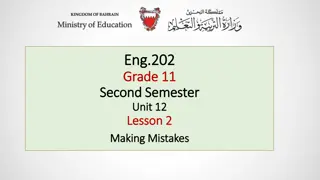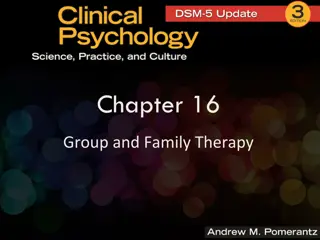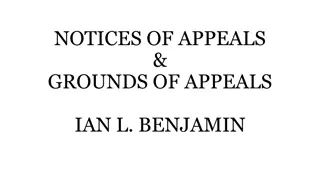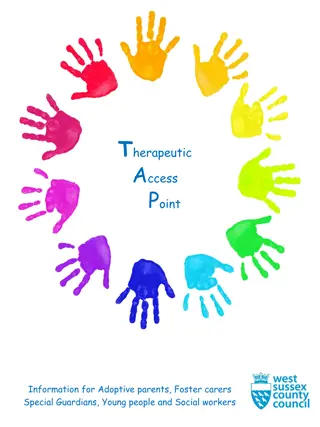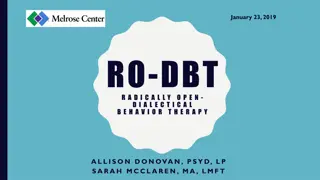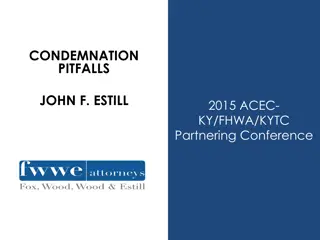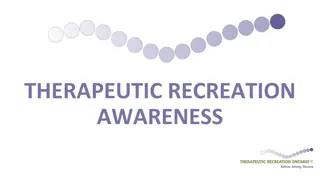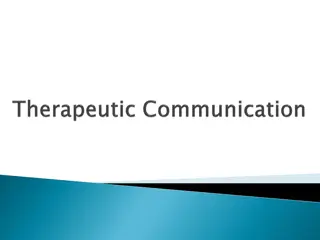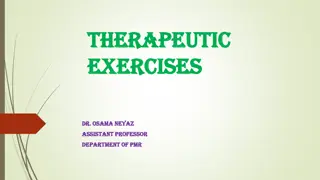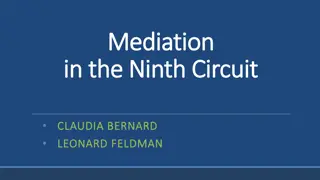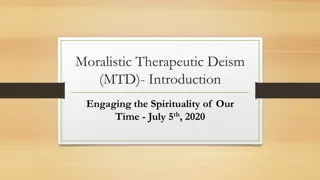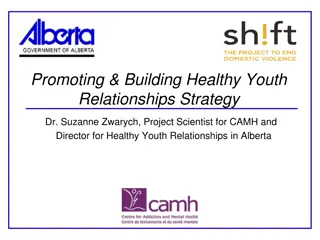Understanding Mistakes, Disruptures, and Enactments in Therapeutic Relationships
Exploring the interconnected nature of mistakes, disruptures, and enactments in therapeutic relationships, with a focus on the impact of errors on the therapeutic process and the potential for growth and repair within the relational context. Various models and approaches in psychotherapy are discussed, emphasizing the importance of addressing ruptures and failures for healing and transformation.
Download Presentation

Please find below an Image/Link to download the presentation.
The content on the website is provided AS IS for your information and personal use only. It may not be sold, licensed, or shared on other websites without obtaining consent from the author. Download presentation by click this link. If you encounter any issues during the download, it is possible that the publisher has removed the file from their server.
E N D
Presentation Transcript
We are born and formed in relationship with each other, with ourselves, and with the environment and culture, and we seek to make and retain relationships and attachment at all costs. We are wounded in relationships and will most likely be healed in relationship. It is not difficult to appreciate that rupture, mistakes, and failure, seen through the lens of our relational existence and the influence of attachment, call forth from us the ideas of blame, shame, retribution, forgiveness, and redemption. Carole Shadbolt (2012) The Place of Failure and Rupture in Psychotherapy, Transactional Analysis Journal, 42:1, p.6
As much as I want to make the case for a nuanced difference between a mistake, a disrupture, and an enactment in the therapeutic relationship, I also think there is a the link between them in the sense that errors of professional or clinical judgment may arise because, as Bromberg (2011) suggested, we therapists foreclose on a therapeutic process when we become frightened of the mess or our sense of the gap between rupture and repair becomes difficult. Discuss examples of mistakes, disruptures and enactments. Katherine Murphy (2012) From a Fumbled Beginning: If You Don't Make a Mistake, You Don't Make Anything, Transactional Analysis Journal, 42:1, 28-33
Model One (1 Person) Model Two (1 and Person) Model Three (2 person) Model Drive-conflict model Deficiency-compensation model Relational-conflict model Method Therapist sees herself not as a participant in a relationship, but as an objective observer of the patient. Filling in structural deficit and consolidating the self by way of the therapist's restitutive provision. Patient and therapist as constituting a co- evolving, reciprocally mutual, interactive dyad - each participant initiating and responding. Advocates Enhancement of knowledge Provision of experience Engagement in relationship Relationship Analytic Reparative Authentic Object Relationship Neutral object (whose focus is on the patient's internal process) Empathic self-object or good object-good mother (whose focus is on the patient's moment-by- moment affective experience) Authentic subject (whose focus is on the intimate edge between them) Goal Short-term goal is enhancement of knowledge, the ultimate goal is resolution of structural conflict. Immediate goal is provision of (corrective) experience, the long- range goal is filling in structural deficit. Short-term goal is engagement in relationship (and a deepening of connection between patient and therapist), the ultimate goal is development of capacity for healthy, authentic relatedness. TA School? Classical TA - Redecision Cathexis - Integrative TA Relational Co-creative Sources: Martha Stark (1999) Modes of Therapeutic Action & A summary of the introductory chapter to the book, with commentary and critique by Michael Soth (2015)
Model One Model Two Model Three Model Drive-conflict model Deficiency-compensation model Relational-conflict model Method Therapist sees herself not as a participant in a relationship, but as an objective observer of the patient. Filling in structural deficit and consolidating the self by way of the therapist's restitutive provision. Patient and therapist as constituting a co-evolving, reciprocally mutual, interactive dyad - each participant initiating and responding the locus of the therapeutic action always involves this mutuality of impact. Advocates Enhancement of knowledge Provision of experience Engagement in relationship Relationship Analytic Reparative Authentic 1 Person ? 1 and Person ? 2 person ?
Martha Stark offers Three Modes of Therapeutic Action: Enhancement of knowledge Provision of experience Engagement in relationship if the therapist is to be optimally effective, then she must be able to work comfortably within all three models of therapeutic action sometimes first using one approach, and then another, sometimes using two or three approaches simultaneously. (p. xxiii) The most effective listening stance is an optimal balance between: A neutral object An empathic self object An authentic subject (p.4) Where do you find your inner therapist lands in the therapy room? Where are you most comfortable? What have you experienced in your own therapy? Martha Stark (1999) Modes of Therapeutic Action
One person psychology From a classical transactional analysis perspective, we might think of failure as failure to make, complete, or achieve a behavioral contract or failure to protect adequately a client from what we have come to know as script backlash following a premature redecision. Or it might represent those times when we neglect to confront a discount or we stroke an invitation to symbiosis. One and half person psychology Integrative transactional analysis, which brings together transactional analysis, object relations theory, and developmental perspectives. The therapist offers a reparative emotional experience through empathy, attunement, and inquiry. He or she may even meet a hitherto unmet relational need. From this perspective, failure might be seen as the therapist failing to appreciate the relational needs of the client, and a rupture is experienced as a repeat in the here and now of the experience of unmet needs of a fixated archaic ego state. Two person psychology Relational transactional analysis, on the other hand, is a two-person perspective and has as its object the relatedness between therapist and client, which is intentionally used toward the goal of authentic mutual relating A two-person perspective requires us to move beyond this idea of mistake or failure. I suggest that what some call ruptures or failures are both forms of communication and an attempt at connection. They are signals that something has or has not occurred between the working pair, that something has been disturbing, angering, puzzling, or, alternatively, unexpressed or lost while at the same time wanted. Carole Shadbolt (2012) The Place of Failure and Rupture in Psychotherapy, Transactional Analysis Journal, 42:1, p.9-11
At these moments, we as therapist are genuinely, authentically impacted by the real mutual power of the relational pair without having to choose between agency and attachment. As a result, meaning is explored, and the experience of both client and therapist is validated from the standpoint of cocreating an alternative, a fresh and new third experience. Carole Shadbolt (2012) The Place of Failure and Rupture in Psychotherapy, Transactional Analysis Journal, 42:1, p.12 What is happening here in terms of ego structure?
The therapist must stand ready to engage authentically in the moment with what is happening in the room The therapist s job is to be curious rather than interpretative or evaluative, inquiring and reflective about the client s and the therapist s subjective experience and truth. It is important to be attentive and willing to engage with what is occurring, not an easy task when the therapist s own material may be part of what is causing the rupture At such moments the therapist can experience being in and out of the work at the same time. Part of the task is to own and reflect on the transferences and countertransferences and then carefully and thoughtfully self-disclose real dilemmas and own one s mistakes. Carole Shadbolt (2012) The Place of Failure and Rupture in Psychotherapy, Transactional Analysis Journal, 42:1, p.12
the place of the therapists experience, emotions, and disturbances during the therapeutic encounter and his or her ability to metabolize or hold and reflect on these in himself or herself are axiomatic to transformation (or change). Carole Shadbolt (2012) The Place of Failure and Rupture in Psychotherapy, Transactional Analysis Journal, 42:1, p.7
Self Disclosure
Personal Disclosure
Self-disclosure is the cornerstone of the shared experience or cocreated dynamic, and if it is successful, both individuals discover, or perhaps rediscover, hope in their joint, relational endeavors. The uncertainty of self-disclosure requires the therapist to ruthlessly, sometimes contemporaneously, examine his or her own motivations for revealing thoughts, feelings, and behaviors brought about during the work. Ill-thought-out, exploitive, or narcissistic self-disclosure or self-disclosure that is done continuously or to ward off anxiety or vulnerability about a client s anger functions as a defense that is unlikely to result in genuine transformation of a rupture, except perhaps to make it worse Without the support of an ethical stance, the work has no frame and thus has the possibility of unraveling. Carole Shadbolt (2012) The Place of Failure and Rupture in Psychotherapy, Transactional Analysis Journal, 42:1, p.12
A Relational Approach to Rupture Carole offers a sequence of phases. 1) Acknowledgement something has occurred, the moment and process of self-disclosure 2) Space for genuine interpersonal exchange and awareness no n defensive manner 3) Describe the experience rather than define the other 4) Inquire rather than interpret 5) Meaning making making meaning of the rupture, hearing about feelings. 6) Transformation the relational search for meaning can sometimes lead to transformation we live a different experience. Curiosity is an emotion. It s action is calming of the Amygdala.
Safran and Muran (2000), citing Heather Harper, divided rupture into two types: withdrawal ruptures and confrontation ruptures. In a withdrawal rupture, the client, or sometimes the therapist, disengages. Some withdrawal ruptures are obvious and behavioral in nature. Others are less obvious as our clients adapt to or accommodate to us or we to them. Confrontation ruptures are more florid. Anger, resentment, fury, and dissatisfaction are often directly, loudly, and sometimes frighteningly expressed. Both types of rupture reflect the need for what Saffran and Muran call agency and relatedness (p. 31). Agency is similar to the transactional analysis principles of autonomy and self-determination. Relatedness refers to the need for attachment. To Saffran and Muran, a rupture denotes the tension between the possible loss of either one of these desires by having to choose one over the other, that is, either choosing autonomy or attachment. If the choice is autonomy, attachment is lost and vice versa, in other words, there is an impasse. They focused on the client feeling the rupture, but, of course, the therapist may as well. Carole Shadbolt (2012) The Place of Failure and Rupture in Psychotherapy, Transactional Analysis Journal, 42:1, p.11
So how do we recognize a rupture in the context of a therapy session? Aside from the obvious dramatic confrontational rupture described by Safran and Muran (2000), ruptures can be recognized because they are disturbing and have shape. By this I mean that as we sit with our clients, we may become aware that the session has suddenly or gradually developed a different mien. We may become aware of some subtle discomfort inside us that suggests that things are not running as smoothly as we had first imagined. The client s face has or has not changed expression, and we know that he or she is experiencing something that was generated between us. Somehow we have sailed into a different and unknown place, and suddenly we are not sure of anything. We have made a mistake. Alternatively, a client may appear in our dreams or may be on our minds between sessions. We feel worried or dissatisfied with ourselves over a small, seemingly inconsequential comment by the client Carole Shadbolt (2012) The Place of Failure and Rupture in Psychotherapy, Transactional Analysis Journal, 42:1, p.12
Ethics of enactments: Minding the Gap between intention and outcome Sue Eusden The Gap The intersubjective space Falling between minds a primitive forgetting Between safety and risk It is my view that therapists often act unethically in their practices, not through gross misconduct but through inattention, going for an easy option (e.g., soothing rather than disturbing), or making poor interventions. These are more likely to be definable as unethical when therapists do not attend to the gap created by their actions. Such moments may be experienced as ineffectual, at best, and abusive, at worst. (p.102) When a therapeutic relationship ruptures, the therapist has a duty of care to the client, the therapist himself or herself, and the profession, a responsibility to bring his or her mind to the possible enactment they have entered into and that has resulted in a loss of the capacity for reflection. (p.103) Like learning many skills, be it baseball or playing the piano, being a therapist requires dedication to detail, disciplined practice, and a passionate commitment to getting better every day. For me this work involves a lifetime of practice, with qualification serving only as a marker of basic competence for entering into deep practice. (p.112) Sue Eusden (2011) Minding the Gap: Ethical Considerations for Therapeutic Engagement, Transactional Analysis Journal, 41:2, 101-113
Minding The Gap The intersubjective space The gap is an intersubjective space between the client and myself that is both conscious and unconscious. It is also the space between my intention in making an intervention and how the other receives and perceives that intervention (i.e., its impact). It is the gap between our minds. It is in this space that an intervention that is intended to be transformative can be experienced as abusive or unethical Falling between minds from enactment to transformation In working with people who bring their states of distress, dissociation, and despair into the room, we as practitioners need to be willing to be recruited into their unconscious worlds. This is inevitable, desirable, and risky. However, as these fragmentary self-states try to enter into the human conversation, they may evoke ethical disorganization in the therapist. This is when minding the gap between positive therapeutic intention and unconscious participation in an enactment becomes critical Between safety and risk allowing and seeking some risk in psychotherapy opens possibilities in the therapeutic relationship. This needs exquisite attention from the therapist as well as a commitment to our own therapy and supervision I would argue that when we only provide a corrective emotional experience (a one-and-a half mode), we foreclose the possibility of something more vital emerging (i.e., the client finding himself or herself). Analyse Sue s case study and find examples of falling between these three gaps and the curiosity that found them? Sue Eusden (2011) Minding the Gap: Ethical Considerations for Therapeutic Engagement, Transactional Analysis Journal, 41:2, 101-113
Clinical Example: Ethics in Everyday Practice One client, whom I will call John, arrived for his session agitated and uncharacteristically late. He began with a story about how he had been tailgated down the hill by some irresponsible woman with children in her car. He was outraged, first that someone would drive in such a dangerous manner and second that she would put her children at risk. This story came after a session in which we had explored whether John would reconnect with his children after several years following a major rupture between them. He could not find it in his heart to forgive them. I had found myself encouraging him to follow the lead of one of his adult children, who had made contact. I had put both feet in, stirred by my own experience of having successfully reconnected with my own father after years of estrangement. John, however, felt tailgated by my persistent encouragement and that I was missing his vulnerability. I had had a sense of pushing for reparation but no awareness of how he was experiencing that pushing. In his story, John indicated that the way he responded to the woman in the car was to slow down and drive well within the 30-mile-an-hour limit; by doing so, he felt he had gained the moral high ground and was powerful and in control. We explored the meaning of this story for our relationship. When I asked, John agreed that he felt that I had been tailgating him. He really did not want to return the call to his daughter. He not only felt pushed by my stepping into the frame but also by his desire not to disappoint me. We came to understand that he needed me to keep in the foreground my respect for him and his ability to find his own way, regardless of what that was, and that I not impose my own story or expectations on him. When I was able to express my desire for him to find meaning in the rupture with his children without defining the outcome and the best way of doing it, he felt heard and learned that being in contact with a disappointed woman can lead to a mutually respectful dialogue. He had no experience of this being possible and had always left at that point in prior relationships. Sue Eusden (2011) Minding the Gap: Ethical Considerations for Therapeutic Engagement, Transactional Analysis Journal, 41:2, p. 101-103
The Intersubjective Space The gap is an intersubjective space between the client and myself that is both conscious and unconscious. It is also the space between my intention in making an intervention and how the other receives and perceives that intervention (i.e., its impact). It is the gap between our minds. It is in this space that an intervention that is intended to be transformative can be experienced as abusive or unethical Transitional space exists in an intermediate area between the realms of fantasy and reality, subjective and objective, and/or internal and external. Transitional experience involves entering into this metaphorical space and requires the capacity to accept the paradox something is simultaneously real and illusory. It thus serves as a bridge between inner and outer worlds and as an alternative to mutually exclusive options of subjective or objective The reality is that this approach involves ethical risks if one enters the transitional space and ethical risks if one does not. The ability to use transitional space is closely related to the capacity to play. Winnicott s (1967/1971) writing on play has helped me to consider flexibility, fluidity, and experimentation in my work. He reminds us that we have the freedom to explore as well as a responsibility to do so Minding the gap is, for me, about attending to my interventions and their impact while staying exquisitely curious about what emerges and remaining available to explore the dynamic disturbance that may unfold. It is often at the edges of the relationship the misattunements, absences, and ruptures that the deeper, more unconscious forms of relating emerge rather than at the point of attunement and empathic inquiry. Sue Eusden (2011) Minding the Gap: Ethical Considerations for Therapeutic Engagement, Transactional Analysis Journal, 41:2, p. 105-106
Falling between Minds: From Enactment to Transformation In working with people who bring their states of distress, dissociation, and despair into the room, we as practitioners need to be willing to be recruited into their unconscious worlds. This is inevitable, desirable, and risky. However, as these fragmentary self-states try to enter into the human conversation, they may evoke ethical disorganization in the therapist. This is when minding the gap between positive therapeutic intention and unconscious participation in an enactment becomes critical One Foot In, One Foot Out: Moving from Relational Unconscious to Relational Consciousness For example, the transference with a client might involve a silent withdrawal that stimulates the therapist to work harder. The client may then feel defined and boxed in, at which point the therapist may pursue, seeking understanding but also fearing a rupture. Both dance the enactment of the impasse between revenge and compassion, cocreating an old but familiar routine. The relating has an I-It (Buber, 1923/ 1958), mutually objectifying quality, and the therapist has both feet in the countertransference. Both individuals have fallen into an inevitable mindlessness. Such moments capture the ethical tensions of our work The therapist takes one foot out by adopting an attitude of curiosity and mindfulness and asking such questions as: What is going on here? What am I enacting of my own? What is the client showing me that I am not understanding? How have I stimulated this in the client and vice versa? Thus, the therapist takes his or her mind to the dyad in a different way. The aim, in so doing, is to also invite the client into wondering. Sue Eusden (2011) Minding the Gap: Ethical Considerations for Therapeutic Engagement, Transactional Analysis Journal, 41:2, p. 107
Safety and Risk Risk and uncertainty are inescapable existential challenges that all humans face, including therapists and clients. We often talk of minimizing risk by skillful assessment, but perhaps we need skillful assessment to maximize risks! Risk taking can be an enlivening process in therapy, for example, when the therapist engages with difference, conflict, and play as the focus of the work. This requires that he or she have skills and self-awareness as well as a willingness to take account of the unconscious process of both the client and himself or herself. The clinician risks being changed for better or worse by the encounter Winnicott (1950/1958a) talked about babies not needing satisfaction but rather someone to come up against. I think this applies to the therapeutic relationship as well. In an ordinary developmental process, there is a need for a certain amount of risk in order for the infant to learn, grow, and develop a separate sense of himself or herself. Panksepp (2004) talked about rough and-tumble play and how critical it is to regulate emotions, develop an embodied sense of relatedness, and feel pleasure and joy. My understanding is that as we engage in the rough and tumble of a therapeutic relationship, we help clients expand their capacities to tolerate more pain and therefore more pleasure (this is my favorite definition of psychotherapy). The implications of this are that allowing and seeking some risk in psychotherapy opens possibilities in the therapeutic relationship. This needs exquisite attention from the therapist as well as a commitment to our own therapy and supervision I would argue that when we only provide a corrective emotional experience (a one-and-a half mode), we foreclose the possibility of something more vital emerging (i.e., the client finding himself or herself). Sue Eusden (2011) Minding the Gap: Ethical Considerations for Therapeutic Engagement, Transactional Analysis Journal, 41:2, p. 110



